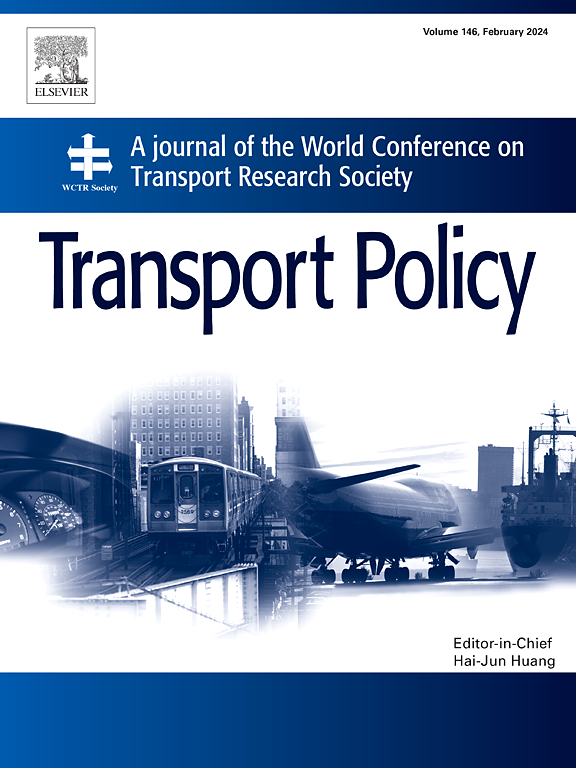Spatial–temporal evolution theory and influencing mechanisms of the express delivery network: A case on YTO express in China
IF 6.3
2区 工程技术
Q1 ECONOMICS
引用次数: 0
Abstract
As a typical network industry, the express delivery industry has become an essential component of economy and society today. However, due to insufficient theoretical foundations and a lack of data, research on the spatial–temporal evolution and influencing factors of express delivery networks remains relatively limited. This study adopts a social network theory framework to construct mechanisms of spatial–temporal evolution of express delivery networks. It identifies that express delivery networks tend to form a “core–periphery” structure, where development occurs first in economically advanced and geographically accessible regions, with regional core nodes serving as hubs that connect sub-networks. Using internal datasets from YTO Express for 2013 and 2017, we construct a directed weighted network to examine the spatial structure and evolution characteristics of China’s express delivery network. Additionally, we explore the influencing factors from the perspectives of both edges and nodes in the demand and supply networks. The results show that the YTO Express network exhibits a clear east–west distribution pattern, with dense concentrations in the east and sparse distributions in the west, aligning with the small-world phenomenon. In terms of spatial dimension, the network shows a trend of fragmentation transitioning towards aggregation, while in temporal terms, it evolves from inefficiency to efficiency. Key factors influencing network node attributes include the development of the internet, economic growth, transportation, and geographical factors. The development of the express network is closely related to the economic correlation network, and both of them have a positive influence on each other, while the economic correlation network has a more obvious promotion effect on the express network. Finally, we propose optimizing transportation routes, increasing regional hub nodes, and combining express network design with e-commerce warehouse distribution.
快递网络时空演化理论及影响机制——以圆通快递为例
快递业作为一个典型的网络行业,已经成为当今经济和社会的重要组成部分。然而,由于理论基础不足和数据缺乏,对快递网络时空演化及其影响因素的研究相对有限。本研究采用社会网络理论框架,构建快递网络时空演化机制。报告指出,快递网络倾向于形成一种“核心-外围”结构,在这种结构中,发展首先发生在经济发达和地理上可达的地区,区域核心节点作为连接子网络的枢纽。利用圆通快递2013年和2017年的内部数据集,构建了一个有向加权网络,分析了中国快递网络的空间结构和演化特征。此外,我们还从供需网络的边缘和节点两个角度探讨了影响因素。结果表明:圆通快递网络呈现出明显的东西分布格局,东密集西稀疏,符合小世界现象;在空间维度上,网络呈现由碎片化向聚集化过渡的趋势,在时间维度上,网络呈现由低效率向高效化演进的趋势。影响网络节点属性的关键因素包括互联网的发展、经济增长、交通和地理因素。快递网络的发展与经济关联网络密切相关,两者之间存在着相互正向影响,而经济关联网络对快递网络的促进作用更为明显。最后提出优化运输路线,增加区域枢纽节点,将快递网络设计与电子商务仓储配送相结合。
本文章由计算机程序翻译,如有差异,请以英文原文为准。
求助全文
约1分钟内获得全文
求助全文
来源期刊

Transport Policy
Multiple-
CiteScore
12.10
自引率
10.30%
发文量
282
期刊介绍:
Transport Policy is an international journal aimed at bridging the gap between theory and practice in transport. Its subject areas reflect the concerns of policymakers in government, industry, voluntary organisations and the public at large, providing independent, original and rigorous analysis to understand how policy decisions have been taken, monitor their effects, and suggest how they may be improved. The journal treats the transport sector comprehensively, and in the context of other sectors including energy, housing, industry and planning. All modes are covered: land, sea and air; road and rail; public and private; motorised and non-motorised; passenger and freight.
 求助内容:
求助内容: 应助结果提醒方式:
应助结果提醒方式:


